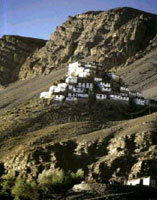A Journey into Discovery Tucked away in the craggy folds of the Himalayas is a land that few people know about, fewer still have crossed this way, for it has been one of the world's best kept secrets for thousands of years. |
|
|
| |
|
|
Day 1
Arrive Delhi.
15-seater internal flight to Kullu.
O/n hotel in Manali.
Day 2
Day to relax and enjoy Manali.
Visit to Hadimba Temple.
O/n hotel in Manali. Day 3
Jeep safari to Kaza and camp.
Day 4
Sightseeing around Kaza camp (13,000ft).
Day 5
Day trek to Ki, Kibber (14,000ft) and Gete (14,220ft) through the Kibber Wildlife Sanctuary. Day 6
Jeep safari to Tabo.
Day 7
Day trek to Dhankar and Lhalung. Day 8
Jeep safari at Pin Valley National Park. Day 9
Jeep safari to Chandratal Lake (14,560ft). Day 10
Jeep safari to Chandratal Lake (14,560ft). Day 11
Day in Naggar.
O/n Naggar Castle. Day 12
Internal flight to Delhi.
Shopping and sightseeing in Delhi.
O/n hotel in Delhi. Day 13
Taj Mahal.
O/n hotel in Delhi. Day 14
Return.
When: June - Sept
Level: 2 
|
|
|
|
We find the amazing Chandratal Lake (4270m) and high valleys that until recently were forbidden lands. Access to Spiti, North India, this remote and rugged corner of the world has only been possible since 1992.
Relatively few travellers visit this pristine area, a factor that greatly adds to its appeal .For just a few months every year, the Himalayan valleys of Spiti emerge from a thick cloak of snow to reveal a different, secret world to man. Frozen glaciers and rivers start to flow with unseen fury, the earth dramatically changes colour, mountains unlock secret doorways and local inhabitants come out in celebration of life itself. At dizzying heights of 2700m to 4300m the experience is almost surreal.
|
|
|
|
Spiti is one of India's remotest regions, this area is full of natural beauty and warm, welcoming people. Mahayana Buddhism took a firm hold over 1000 years ago and this is one of the last areas in which it is freely practised. Julay is a handy word to know, meaning hello, goodbye, good luck, please and thank you.
|
|
|
 |
Ki Monastery, perched high on a mountain above the Spiti River is so close to Tibet in landscape, distance and feeling. It s the oldest and largest gompa in Spiti dating back to the 10th Century. It was built by Ringchen Zangpo and belongs to the Gelupa order. There is a priceless collection of ancient thankas, including Tibetan silk thankas up to 800 years old and frescoes depicting the life of Guru Rinpoche, Padmasambhava. |
|
|
Kibber is a small village 11km from Ki, with the claim to being the highest village in the world at 4205m, although we have found that Gete (4270m), another village 7km East of Ki has a better claim to this honour. Kibber was a part of the overland salt trade from Tibet centuries ago. It is a beautiful and remote tiny village. Spiti contains 2 wildlife reserves, the Kibber Sanctuary and the Pin Valley National Park, which was established to conserve the habitat of the ibex, blue sheep and snow leoipard. The summer is the time for avian visitors, including rose finches, swifts, larks, but only a few stay to brave the winter. We will trek to colourful gompas, through small traditional villages, exploring for fossils en route. We visit Chandratal Lake (4270m) which tells us the love story of the meeting of the Hindu Gods, Chandra and Bhaga, but also marks the confluence of the Chandra and Bhaga Rivers. Here with spectacular scenery of the surrounding snowy peaks reflected in crystal clear waters, you will have time to celebrate your achievement and reflect on a journey in a part of India quite removed
from the rest.
In India's bustling capital Delhi, a labyrinth of streets and markets crowded with exotic produce and a bewildering mix of people, you can 'shop 'til you drop' or take in Delhi's sights including the Red Fort, Jami Masjid and Raj Ghat. Or if you prefer a day trip to one of the seven wonders of the world, the Taj Mahal; built in 1631 by Emperor Shah Jahan in memory of his beloved wife, it is described as the most extravagant monument ever built for love.
|
|
|
|
|
|
|
|
|
|
The rich variety of the city provides dramatic contrast and a superb finish after the secret, unforgettable kingdom of the Indian Himalayas.
|
|
|
|
|
|
|
|
|
|
|
|
![]()
